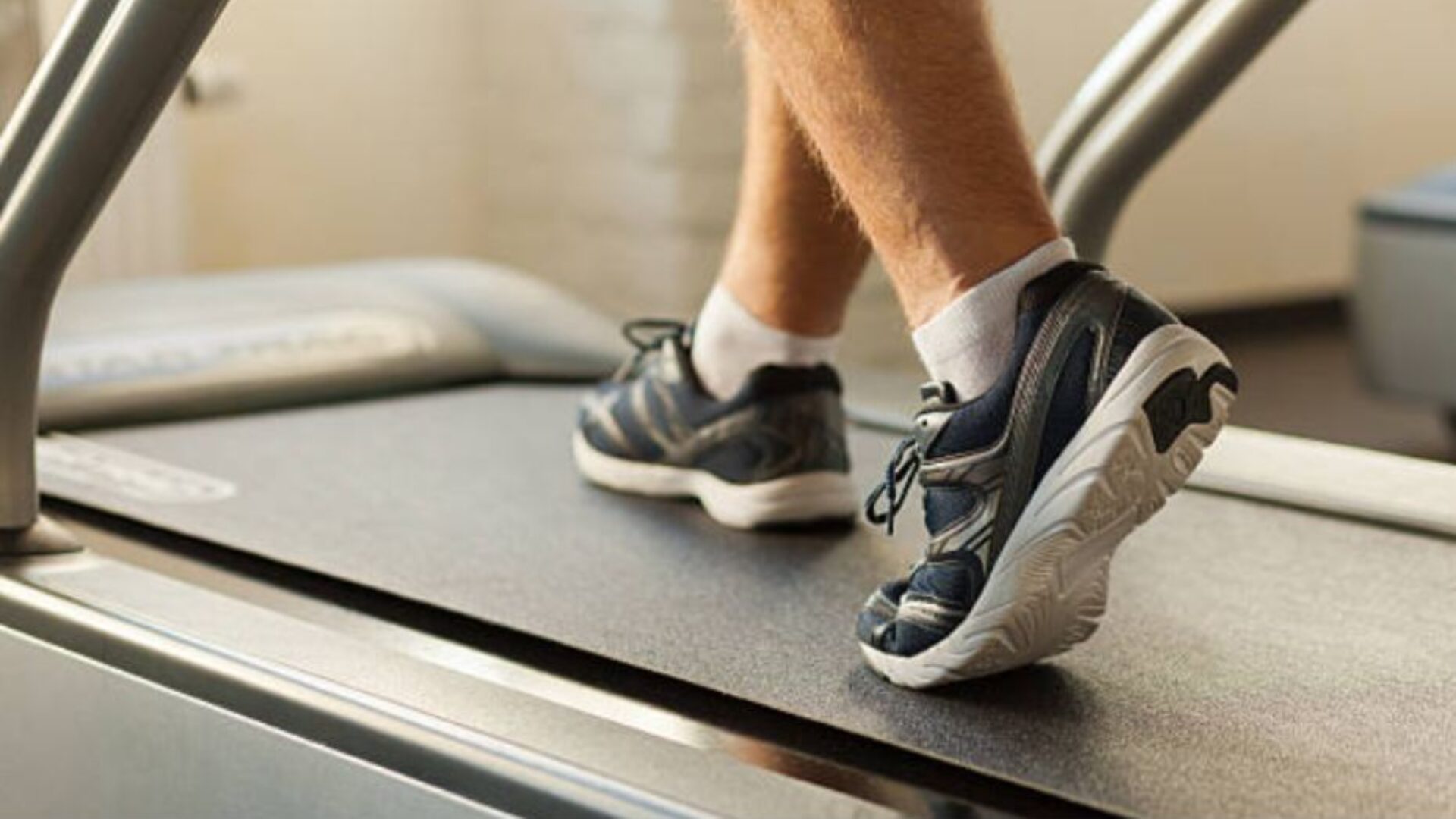A strong back isn’t just about looks; it’s the backbone of our day-to-day movements and overall well-being. Think about it: whether you’re sitting at a desk, picking up groceries, or playing your favorite sport, your back muscles are always at work. They keep us standing tall, support good posture, and help prevent those pesky aches and pains.
Now, let’s talk about cable machines. These nifty pieces of gym equipment offer a wide range of exercises to target and strengthen your back muscles. They’re like your secret weapon for a more robust and resilient back.
This article is your guide to unlocking the power of cable-based back exercises. We’ll explore exercises like lat pull-downs and seated rows that can help you build a stronger back effectively.
But why focus on the back? Well, it’s not just about having a toned back – it’s about having the strength and flexibility to move comfortably and reduce the risk of injuries.
We discover how these cable exercises can transform not only the look of your back but also your overall strength and well-being. It’s time to embrace a stronger, more capable you!
Advantages of Cable Back Workouts
Let’s talk about why cable machines are a game-changer for your back workouts. These machines bring a unique advantage – they maintain consistent tension throughout each movement. Picture it as a steady pull that keeps your muscles engaged from start to finish, promoting growth and strength.
What’s more, the versatility of cable machines opens up a world of possibilities. By adjusting handles and angles, you can zero in on specific areas of your back – be it the lats, rhomboids, traps, or rear deltoids. This customization ensures a well-rounded workout that targets the exact muscles you want to strengthen.
One of the best things about cable exercises is the control they offer. You get to dictate the pace and precision of each movement, allowing for better muscle engagement and reduced injury risk. This level of control isn’t just about building muscles; it’s about doing it safely and effectively.
To sum it up, cable machines bring a mix of benefits to the table – sustained tension, targeted muscle engagement, and precise control. This guide will walk you through a variety of cable-based exercises, sharing their unique advantages and techniques. Get ready to build a stronger, more resilient back with these tried-and-tested workouts.
9 Best Cable Back Workouts For a Strong Back
Let’s dive into these 9 back exercises using cables that will help you achieve a stronger and more defined back.
Beginner Cable Back Workouts
1. Cable Rows

Cable rows are a fantastic exercise that really hones in on your mid-back muscles, particularly the rhomboids and latissimus dorsi. If you’re looking to improve your posture and build a strong foundation for your back, this exercise is a must-try.
Here’s a breakdown of how to perform cable rows correctly:
- Getting Set Up: Sit comfortably in front of the cable machine, making sure your feet are firmly planted for stability. This is your starting point.
- Grip and Posture Check: Grab the handles of the cable machine with your palms facing downward. Keep your back straight and relax your shoulders. Good posture is crucial throughout the exercise to avoid strain.
- Time to Pull: Pull the handles towards your torso smoothly and steadily. As you do this, focus on squeezing your shoulder blades together. This action really targets those mid-back muscles we’re aiming for.
- Feel the Contraction: When you’ve pulled as far as you comfortably can, pause for a moment. You should feel a good tension in your mid-back muscles – that means they’re engaged.
- Back to Start: Now, slowly release the tension on the cable and extend your arms back to the starting position. Keep control throughout this movement; don’t let the weight yank your arms back suddenly.
- Repetition and Sets: Aim for about 8 to 12 reps per set, adjusting the weight so it’s challenging but still allows you to keep proper form. Remember to engage your core for stability and focus on the muscles you’re working.
Pro Tip: When doing cable rows, keep it smooth and controlled. Focus on feeling your back muscles doing the work instead of using jerky movements. Try changing your grip on the handles to hit different parts of your back. As you get stronger, add more weight gradually. But always remember, technique beats heavy weights. Keep it steady to avoid injuries and get the best results for your back!
2. Cable Lat Pulldown
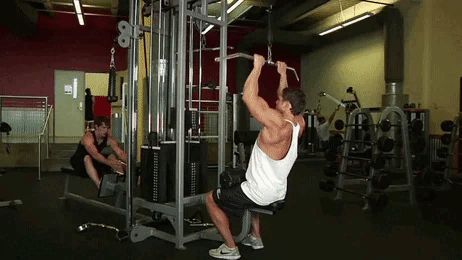
The Cable Lat Pulldown is like a secret weapon for building a strong and impressive upper back. It’s all about those lats – those big, beautiful muscles that give your back that V-shape and make you feel like a superhero!
How to Perform Cable Lat Pulldown:
- Setting Up: Let’s get started by setting up the cable machine. Attach the wide-grip bar to the pulldown machine. Take a seat, making sure your thighs are comfortably positioned under the padding. Grab the bar with a grip slightly wider than your shoulders.
- Get Your Posture Right: Sit up tall, chest out, and shoulders back. Your lower back should have a slight arch. Grab that bar with both hands and fully extend your arms overhead – this is your starting position.
- Pulling Action: Take a deep breath out and start pulling the bar down towards your upper chest. Keep those elbows pointing downwards, and really focus on using your back muscles to do the work. Think about pulling your elbows towards your hips – that’s how you’ll engage those lats!
- Feel the Squeeze: When the bar is close to your upper chest, pause for a second and give those back muscles a good squeeze. Feel the power in those lats before slowly returning the bar to the starting position.
- Controlled Release: Inhale and let your arms extend back up, but don’t let the tension on your lats disappear. Keep those muscles engaged even when you’re returning to the starting position.
- Reps and Sets: Aim for around 10 to 12 reps per set. Quality over quantity is what matters. Adjust the weight to challenge yourself without sacrificing form.
Pro Tip: Focus on your posture and feel those muscles working! Sit up tall, chest out, and pull your shoulders back to engage your upper back. When pulling the bar down, imagine pulling your elbows towards your hips—this really targets those big back muscles, the lats. Take a pause at the bottom to squeeze those muscles tight before slowly returning to the starting position. Keep the tension in your muscles throughout the movement. Quality beats quantity, so aim for 10 to 12 reps with perfect form. Adjust the weight to challenge yourself while keeping it smooth and controlled for a killer upper back workout that sculpts that V-shaped look.
3. Straight Arm Pulldown
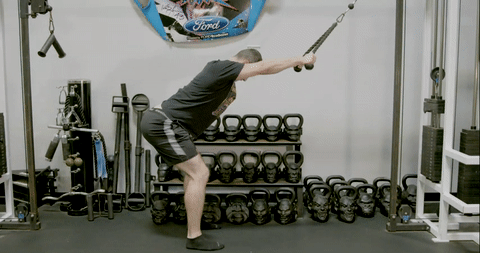
The Straight Arm Pulldown is your ticket to building a rock-solid upper back. This exercise focuses on engaging those upper back muscles, particularly the lats, to enhance strength and definition.
How to Perform Straight Arm Pulldown:
- Setting Up: Begin by adjusting the cable machine. Attach a straight bar to the high pulley and set the weight to a level that challenges you but allows for proper form. Stand facing the machine, and grab the bar with an overhand grip, hands placed slightly wider than shoulder-width apart.
- Getting Positioned: Stand with feet shoulder-width apart, maintaining a slight bend in the knees. Keep your core engaged to stabilize your body throughout the exercise.
- Let’s Pull It Down: Start with your arms fully extended and pull the bar down smoothly toward your thighs. Focus on initiating the movement from your upper back, specifically engaging those lats. Imagine guiding the bar downward using your back muscles, not just your arms.
- Feel the Contraction: As the bar reaches thigh level, hold the position for a second or two. Concentrate on squeezing your back muscles, especially the lats. This pause maximizes muscle engagement.
- Controlled Return: Slowly raise the bar back up to the starting position while maintaining control over the movement. Keep the tension on your back muscles even as you release.
- Repetitions and Sets: Aim for 10 to 12 reps per set. Focus on executing each repetition with proper form and controlled movements. Adjust the weight to suit your strength level while ensuring good technique.
Pro Tip: It’s all about finesse and feeling those upper back muscles work wonders! Keep your core steady and focused as you pull the bar down, envisioning your upper back doing the heavy lifting, especially those lats. Pause at thigh level, let those muscles soak in the squeeze before smoothly guiding the bar back up. Aim for 10 to 12 deliberate reps, each one a testament to your form. Adjust the weight just right, balancing challenge and control, for an upper back workout that sculpts strength and definition.
Intermediate Cable Back Workouts
4. Cable Face Pull with External Rotation
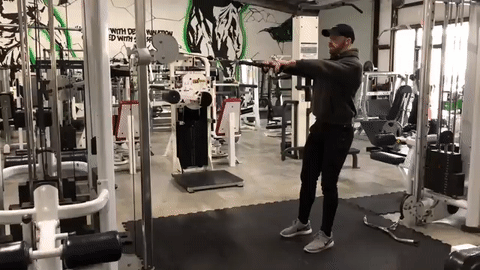
The Cable Face Pull with External Rotation is a fantastic move that works wonders for your upper back, specifically targeting the rear deltoids, upper back muscles, and the rotator cuff. It’s a gem for improving shoulder health, posture, and overall upper body strength.
How to Perform Cable Face Pull with External Rotation:
- Setting Up: To get started, set up a cable machine with a rope or handles attached at the highest position. Stand facing the machine and adjust the weight to a level that challenges you without compromising form.
- Getting into Position: Grab the handles with an overhand grip, palms facing downward. Take a step back to create tension in the cable. Stand with your feet about shoulder-width apart to maintain a sturdy stance.
- Posture Matters: Keep your chest up, shoulders relaxed, and initiate the movement by pulling the handles toward your face. Picture pulling the handles apart as they reach your forehead, making sure your elbows are up and aligned with your shoulders.
- Adding Rotation: When you’re nearing the top of the movement near your face, here comes the twist! Literally. Externally rotate your shoulders by pulling the handles further apart, really focusing on engaging those rear deltoid muscles. Your hands should end up at the sides of your face, in line with your ears.
- Pause and Squeeze: Take a brief pause at the peak of the movement, really feeling that squeeze in your upper back muscles, especially the rear deltoids. It’s all about that mind-muscle connection!
- Gentle Return: Slowly extend your arms, ensuring you control the cable’s resistance. Allow your shoulder blades to come back together as you return to the starting position. Remember, slow and steady wins the race.
- Reps and Sets: Aim for around 10 to 15 reps per set. Focus on the quality of each rep rather than rushing through them. Adjust the weight to suit your strength level while maintaining proper form.
Pro Tip: For the Cable Face Pull with External Rotation, focus on form and control. When pulling the handles towards your face, keep your posture strong. Take your time at the top to really feel the squeeze in your upper back. Remember, it’s not about rushing through reps, it’s about nailing each movement. Gradually increase the weight as you get stronger, but always prioritize doing it right over lifting heavy. Doing this exercise well is awesome for your shoulders, posture, and upper body strength.
5. Kneeling High Cable Row
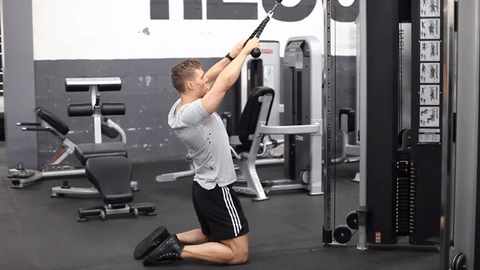
The Kneeling High Cable Row is an awesome exercise that’s all about giving your upper back some serious love. It focuses on those muscles between your shoulder blades, helping you build a strong and robust upper back while also engaging your core for stability.
How to Perform Kneeling High Cable Row:
- Setting Up: Let’s get started by setting up the cable machine. Attach a handle or a bar to the high pulley. Then, kneel down in front of the machine, facing away from the weights. Keep your knees about hip-width apart and find a comfortable distance from the machine.
- Getting Positioned: Grab the handle or bar with an overhand grip, slightly wider than your shoulders. Sit back a bit, making sure your posture is tall and upright. Engage your core muscles to keep yourself steady throughout the exercise.
- Start Pulling: Now, pull the handle towards your upper abdomen or lower chest area by squeezing your shoulder blades together. Keep those elbows close to your body as you pull, making it feel like you’re rowing.
- Feel the Squeeze: When you’ve pulled the handle close to your body, take a moment to really feel that squeeze between your shoulder blades. This is where the magic happens for your upper back muscles!
- Release with Control: Slowly straighten your arms and extend them back to the starting position. Remember, it’s all about control here. No need to rush—keep that movement smooth and controlled.
- Reps and Sets: Aim for about 10 to 12 reps per set. Focus on each repetition, maintaining good form, and avoid swinging the weight. Quality over quantity is the name of the game.
Pro Tip: When doing the Kneeling High Cable Row, focus on your posture and core strength. As you pull the handle towards your upper abdomen or lower chest, really feel those shoulder blades squeezing together—that’s the sweet spot for your upper back. Take your time and control the movement; don’t rush it. Aim for quality over quantity, around 10 to 12 reps per set, while keeping your form spot-on. This exercise not only builds a strong upper back but also amps up your core stability—making it a win-win!
6. Cable Incline Row
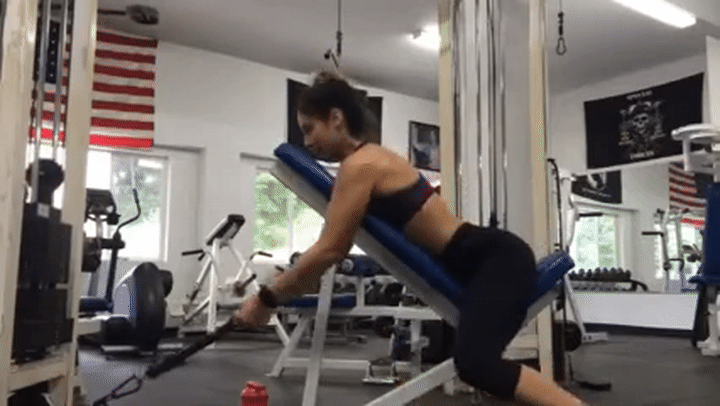
The Cable Incline Row is an incredibly effective exercise that can work wonders for sculpting a robust and impressive upper back. It specifically targets the muscles nestled between your shoulder blades, giving you that chiseled, well-defined appearance and boosting your confidence to stand tall with poise and strength.
How to Perform Cable Incline Row:
- Setting Up: Start by preparing the cable machine. You’ll need a low pulley and an incline bench. Sit on the incline bench facing the cable machine and grab the bar with a grip slightly wider than your shoulders.
- Get in Position: Sit up straight on the bench, puff your chest out, and pull your shoulders back. Your arms should be fully extended, holding the bar in front of you. This marks your initial stance.
- Pulling Motion: Begin pulling the bar toward your lower chest by squeezing your shoulder blades together and bending your elbows. Concentrate on engaging your back muscles to do the heavy lifting rather than solely relying on your arms. Keep your elbows close to your sides as you execute the pull.
- Squeeze and Hold: As the bar approaches your lower chest, hold it there for a brief moment. Feel the intense burn and tightness in your upper back muscles before slowly returning the bar to the starting position.
- Controlled Release: Gradually straighten your arms back to the starting position. Maintain control throughout the movement; avoid letting the weight slam down to sustain tension in your back muscles.
- Reps and Sets: Aim for approximately 10 to 12 repetitions per set. Emphasize the quality of each repetition, ensuring that your form remains precise. Adjust the weight accordingly to challenge yourself while maintaining proper technique.
Pro Tip: Pay attention to your posture and feel those muscles working! Sit upright on the bench, stick your chest out, and roll your shoulders back to activate your upper back. When you pull the bar towards your lower chest, focus on squeezing your shoulder blades together—that’s the key move for a strong back. Take a beat at the top to really feel those muscles working before smoothly returning to the start. Keep it controlled throughout; no dropping the weight suddenly. Aim for 10 to 12 reps with perfect form. Adjust the weight so it challenges you while keeping the movement smooth for a killer upper back workout that sculpts and defines your muscles.
Advanced Cable Back Workouts
7. Cable Shrugs
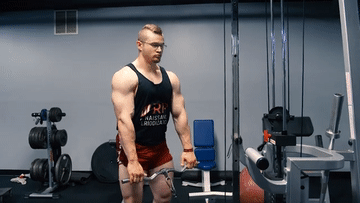
Cable Shrugs are a powerhouse move for sculpting the upper back, honing in on the trapezius muscles. This exercise not only adds strength but also contributes to a more confident posture.
How to Perform Cable Shrugs:
- Setting Up: Begin by setting the cable machine with a straight bar or handles attached to the low pulley. Adjust the weight to a challenging yet manageable level. Face the machine, grab the bar or handles with an overhand grip, and stand with feet shoulder-width apart.
- Getting Positioned: Let your arms hang straight down, then smoothly lift your shoulders straight up toward your ears. Focus intensely on activating those upper back muscles, specifically the traps, to elevate the weight.
- Squeeze and Hold: At the peak of the movement, hold for a brief pause. Visualize your upper back muscles working hard and tighten them a bit more to maximize the engagement at the top of the motion.
- Controlled Lowering: Lower the weight gradually and with control, allowing your shoulders to descend without sudden drops or jerks. Emphasize the slow descent to maintain muscle tension.
- Reps and Sets: Aim for approximately 12 to 15 reps in each set. Pay close attention to form and ensure each repetition is deliberate and effective. Adjust the weight to suit your capabilities while maintaining proper technique.
Pro Tip: Focus on that lift and control! When you raise your shoulders toward your ears, really feel those upper back muscles, especially the traps, kicking in. Hold it at the top, intensify that muscle squeeze. Slowly lower the weight, keeping it steady. Aim for 12 to 15 reps per set, making each one deliberate. Choose a weight that challenges you while keeping your form spot-on. This exercise isn’t just about strength—it’s about crafting a robust upper back and boosting your posture confidence.
8. Single Arm Cable Pull-Ins
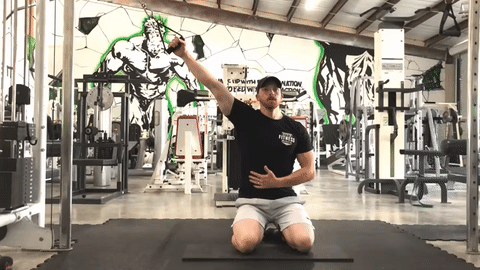
The Single Arm Cable Pull-Ins serve as an excellent tool for sculpting and strengthening the back, especially focusing on the latissimus dorsi. This exercise not only builds muscle but also enhances stability and balance, making it a valuable addition to any workout routine.
How to Perform Single Arm Cable Pull-Ins:
- Setup: Begin by adjusting the cable machine with a D-handle attached to the low pulley. Ensure the weight is set to a manageable level. Stand sideways to the machine with your feet shoulder-width apart.
- Positioning: Grasp the handle with an underhand grip using one hand. Keep your arm fully extended but slightly bent at the elbow. Maintain a straight posture with a engaged core for stability.
- Initiate the Pull: Start pulling the handle across your body towards the opposite side, focusing on activating your lat muscles. Keep your elbow close to your body and aim to bring the handle towards your hip on the opposite side.
- Squeeze and Pause: Once the handle reaches the other side, hold it there for a moment. Feel the contraction in your back muscles, particularly the lats. This pause helps intensify the muscle engagement.
- Controlled Return: Slowly and smoothly extend your arm back to the starting position. Control the movement to maintain tension in your back muscles throughout.
- Repetitions and Sets: Aim for around 10 to 12 reps per arm. Concentrate on executing each repetition with proper form and controlled movements. Adjust the weight to suit your ability while ensuring good technique.
Pro Tip: Focus on controlling your movements and feeling those back muscles working! Keep your body stable and your core tight while pulling the handle across your body towards your hip. As you reach the end of the movement, hold for a moment to really engage those back muscles. Slowly bring your arm back to the start, keeping the tension in your muscles. Aim for 10 to 12 reps on each side, making sure each one counts with perfect form. Adjust the weight to challenge yourself while keeping the movement smooth for a killer back workout that boosts strength and stability.
9. Cable Bent-Over Reverse Fly
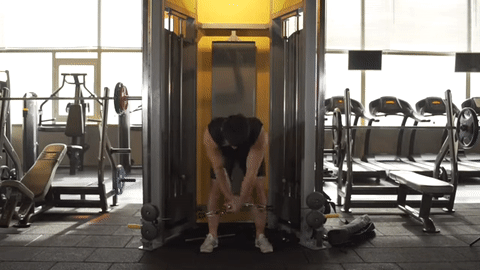
The Cable Bent-Over Reverse Fly is a powerful move that zeroes in on the muscles in your upper back, specifically targeting the rear deltoids and the muscles between your shoulder blades. This exercise not only strengthens your back but also helps in enhancing posture and shoulder stability.
How to Perform Cable Bent-Over Reverse Fly:
- Setup: To get started, adjust the cable machine with D-handles attached to both sides of the low pulley. Set the weight to a level that challenges you without compromising your form. Stand in the middle, facing the machine.
- Positioning: Grab a handle in each hand and bend your knees slightly. Hinge at your hips, leaning forward until your torso is nearly parallel to the floor. Keep your back straight, maintain a slight bend in your elbows, and let your arms hang down toward the floor.
- Initiate the Movement: Start by squeezing your shoulder blades together and raising both arms to the sides until they reach shoulder height. Focus on using your rear deltoids and upper back muscles to perform the movement. Keep your neck in a neutral position throughout.
- Feel the Squeeze: When your arms reach shoulder height, hold the position for a moment and feel the contraction in your upper back muscles. This pause allows for better muscle engagement.
- Controlled Return: Slowly lower your arms back down to the starting position, maintaining control over the resistance provided by the cables. Keep the movement steady and controlled.
- Repetitions and Sets: Aim for around 10 to 12 repetitions per set. Focus on executing each repetition with proper form and controlled movements. Adjust the weight to challenge yourself while maintaining good technique.
Pro Tip: Focus on the feel and form! As you lean forward, pull those shoulder blades together and lift your arms to shoulder height. Feel your upper back and rear deltoids doing the work. Hold for a sec at the top, really feel those muscles engage, then smoothly return. Go for 10 to 12 reps with smooth, controlled moves. Find a weight that challenges but doesn’t strain—aim for that perfect balance. This exercise isn’t just about strength; it’s about crafting a sturdy upper back and better posture.
Essential Guidelines for Back Workouts with Cables
When it comes to getting the most out of cable back exercises, it’s not just about the exercises themselves – it’s about doing them right while keeping safety front and center. Here are some key tips that focus on form and safety, ensuring a rewarding and injury-free workout:
1. Perfect Your Form
Picture this: you’re at the cable machine, gearing up for your back exercises. Remember, form is everything. Keep your back straight and engage your core muscles throughout each movement. It’s not just about the muscles you work; it’s about how you work them.
2. Setting Up the Cable Machine and Choosing Weights
Before you start pulling those cables, take a moment to set up the machine correctly. Adjust the pulleys to match the exercise you’re about to tackle. And when it comes to weights, start with something manageable. It’s okay to begin lighter; you can always increase the resistance as you get into the groove.
3. Safety First
Safety should never take a back seat, especially during back workout using cables. Here’s what you should keep in mind:
- Warm-Up Routine: Don’t skip warming up. Get those muscles ready to roll to avoid strains or unexpected pulls.
- Smooth Movements: Focus on moving smoothly. No sudden jerks or wild swings – they can strain your back or cause injury.
- Breathe Easy: Keep your breathing steady. Exhale during the exertion part of the movement to maintain core stability and protect your spine.
- Check Equipment: Ensure that all cables, handles, and attachments are in good condition and properly secured before starting your routine.
Remember, doing these exercises with precision and keeping safety in mind doesn’t just make your workout more effective; it also minimizes the chances of injuries, giving you better results in the long run.
Frequency and Tips for Optimal Results
- Beginners: Start with two workouts per week, ensuring at least one day of rest between sessions to allow your muscles to recover and adapt.
- Intermediate to Advanced: Aim for three sessions weekly, adjusting weights gradually and incorporating variations to challenge yourself effectively.
- Focus on proper form and controlled movements to prevent injury and maximize the benefits of each exercise.
- Increase the weight or resistance gradually as your strength improves, ensuring a continuous challenge for your muscles.
Consistency, technique, and gradual progression are essential for achieving the best results in your cable-based back workouts.
Final Thoughts
Let’s talk about why a strong back matters and how cable exercises can help you get there.
Your back muscles play a big role in everyday movements and overall strength. Cable exercises specifically target these muscles, giving them a good workout and helping you build a defined and sturdy back.
Incorporating cable exercises into your routine is a smart move. They not only strengthen your back but also improve your posture and stability. With cables, you get a smooth range of motion that engages different parts of your back, giving you that sculpted look.
It’s time to take action! Start adding these cable-based back exercises to your workout routine. Whether you’re a beginner or a seasoned fitness pro, these workouts can fit your level. And don’t forget to listen to your body; adjust the exercises as needed.
Consistency is key in seeing results. Stay committed and watch how these cable exercises transform your back and overall fitness.
FAQs
1. Are cable-based back exercises suitable for beginners?
Absolutely! Start with lighter weights and focus on mastering proper form before increasing resistance.
2. How frequently should one perform these exercises?
It’s recommended to incorporate these exercises 2-3 times a week, allowing for adequate rest between sessions.
3. Can these exercises alleviate back pain?
When executed correctly, these exercises can help strengthen back muscles, potentially reducing the risk of back pain. However, consult a healthcare professional for personalized guidance.
4. Is it necessary to use specific cable machines for these exercises?
While specialized cable machines are designed for these exercises, alternatives can be improvised with resistance bands or pulley systems.
5. Can these exercises be performed at home?
With the right equipment or improvisation, some cable-based exercises can be adapted for home workouts. Ensure safety and proper setup before attempting.




